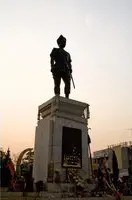Chiang Rai Province is located in the northernmost of Thailand. It is a mountainous region with rivers and jungles, so there is a lot of beautiful nature surrounding the area. The north of Chiang Rai borders Myanmar, the south borders Phayao Province, the east borders Laos, and the west borders Chiang Mai Province.
Chiang Rai population consists of people of various ethnic backgrounds, including those from hill tribes and Chinese lineage. This factors into Chiang Tai’s unique traditions and makes the city an excellent and different location for tourists to experience.
Tips
Chiang Rai has been inhabited since the 7th century, but it was not until 1262 that King Meng Rai established it as the first capital of the Lanna Kingdom. The capital was later relocated to Chiang Mai and since that time Chiang Rai has lived in the shadow of its neighboring province, though for tourists this is a good thing.
Today, Chiang Rai is a traveler’s paradise, endowed with abundant natural attractions and antiquities. Attractions range from ruins of ancient settlements and Buddhist shrines to magnificent mountain scenery and hill tribe villages. For those interested in the natural side of Chiang Rai, jungle trekking is a magical experience; explore the mountains of the north along various hiking trails, many of which access the villages of diverse hill tribal groups, many of whom maintain their traditional lifestyles.
Chiang Rai town, which tends to be a little more ‘laid back’ than its more popular neighbor, now competes with Chiang Mai as a tourist attraction and is fast becoming a popular escape for tourists wanting to leave their troubles behind.
Chiang Rai, the former capital of the great Lanna Kingdom, is a fascinating province filled with cultural and natural wonders, including the Golden Triangle where Thailand, Laos, and Burma come together; an area that was once the hub of opium production, a trade that had much influence on cultural practices and lifestyles. Chiang Rai had stayed off the tourist radar for many years, its people enjoying very leisurely development and mostly traditional, rural lifestyles. Until this day, entire clans live together in bamboo houses and each village has its own individual character.
Recently tourism has boomed in Chiang Rai, where visitors have come to explore the pristine natural beauty of the countryside and immerse themselves in the indigenous culture, including those of a variety of different hill tribe communities. Fortunately for tourists, Chiang Rai is also a center for community development projects, helping rural villagers develop their attractions without adversely affecting their natural and cultural assets.
History of Chiang Rai
The city was founded by King Mangrai in 1262 and became the capital of the Mangrai Dynasty. The word ‘Chiang’ means ‘city’ in Thai, so Chiang Rai would mean ‘the City of (Mang) Rai’. Subsequently, Chiang Rai was conquered by Burma and remained under Burmese rule for several hundred years. It was not until 1786 that Chiang Rai became a Chiang Mai vassal. Siam (Thailand) annexed Chiang Mai in 1899, and Chiang Rai was proclaimed a province of Thailand in 1933.

In 1432, during the reign of King Sam Fang Kaen of the Mangrai Dynasty (1402–1441), the Phra Kaeo, or Emerald Buddha, the most revered Buddha statue, was discovered in Chiang Rai when an earthquake split the chedi at Wat Phra Kaeo of Chiang Rai city. The beautiful jade figure was then seen concealed within. Another telling of the story has the "Emerald Buddha" hastily covered in mud just before marauders entered to pillage. Many years later, the clunky-looking mud Buddha was found to actually house a magnificent jade statue, perhaps by way of the earthquake mentioned above—which caused a piece of the clay to break off—revealing the jade beneath.
In 1992, the city pillar was moved from Wat Klang Wiang to Wat Phra That Doi Chom Thong, where it is known as Sadue Mueang, the "navel" or omphalos of the city.
Chiang Rai